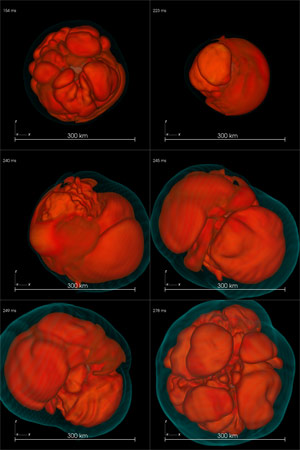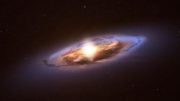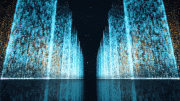
Turbulent evolution of a neutron star for six moments (0.154, 0.223, 0.240, 0.245, 0.249 and 0.278 seconds) after the beginning of the neutron star formation in a three-dimensional computer simulation. The mushroom-like bubbles are characteristic of “boiling” neutrino-heated gas, whereas simultaneously the “SASI” instability causes wild sloshing and rotational motions of the whole neutrino-heated layer (red) and of the enveloping supernova shock (blue). Credit: Images and movie produced by Elena Erastova and Markus Rampp, RZG
Scientists at the Max Planck Institute used some of the most powerful supercomputers in the world to generate elaborate computer simulations showing the violent birth of neutron stars.
A team of researchers at the Max Planck Institute for Astrophysics conducted the most expensive and most elaborate computer simulations so far to study the formation of neutron stars at the center of collapsing stars with unprecedented accuracy. These worldwide first three-dimensional models with a detailed treatment of all important physical effects confirm that extremely violent, hugely asymmetric sloshing and spiral motions occur when the stellar matter falls towards the center. The results of the simulations thus lend support to basic perceptions of the dynamical processes that are involved when a star explodes as supernova.
Stars with more than eight to ten times the mass of our Sun end their lives in a gigantic explosion, in which the stellar gas is expelled into the surrounding space with enormous power. Such supernovae belong to the most energetic and brightest phenomena in the universe and can outshine a whole galaxy for weeks. They are the cosmic origin of chemical elements like carbon, oxygen, silicon, and iron, of which the Earth and our bodies are made of, and which are bred in massive stars over millions of years or freshly fused in the stellar explosion.
Supernovae are also the birth places of neutron stars, those extraordinarily exotic, compact stellar remnants, in which about 1.5 times the mass of our Sun is compressed to a sphere with the diameter of Munich. This happens within fractions of a second when the stellar core implodes due to the strong gravity of its own mass. The catastrophic collapse is stopped only when the density of atomic nuclei — gargantuan 300 million tons in a sugar cube — is exceeded.
What, however, causes the disruption of the star? How can the implosion of the stellar core be reversed to an explosion? The exact processes are still a matter of intense research. According to the most widely favored scenario, neutrinos, mysterious elementary particles, play a crucial role. These neutrinos are produced and radiated in tremendous numbers at the extreme temperatures and densities in the collapsing stellar core and nascent neutron star. Like the thermal radiation of a heater they heat the gas surrounding the hot neutron star and thus could “ignite” the explosion. In this scenario, the neutrinos pump energy into the stellar gas and build up pressure until a shock wave is accelerated to disrupt the star in a supernova. But does this theoretical idea really work? Is it the explanation of the still enigmatic mechanism driving the explosion?
Unfortunately (or luckily!) the processes in the center of exploding stars cannot be reproduced in the laboratory and many solar masses of intransparent stellar gas obscure our view into the deep interior of supernovae. Research is therefore strongly dependent on most sophisticated and challenging computer simulations, in which the complex mathematical equations are solved that describe the motion of the stellar gas and the physical processes that occur at the extreme conditions in the collapsing stellar core. For this task, the most powerful existing supercomputers are used, but still it has been possible to conduct such calculations only with radical and crude simplifications until recently. If, for example, the crucial effects of neutrinos were included in some detailed treatment, the computer simulations could only be performed in two dimensions, which means that the star in the models was assumed to have an artificial rotational symmetry around an axis.
http://youtu.be/8BLiCZISwLY
Thanks to support from the Rechenzentrum Garching (RZG) in developing a particularly efficient and fast computer program, access to most powerful supercomputers, and a computer time award of nearly 150 million processor hours, which is the greatest contingent so far granted by the “Partnership for Advanced Computing in Europe (PRACE)” initiative of the European Union, the team of researchers at the Max Planck Institute for Astrophysics (MPA) in Garching could now for the first time simulate the processes in collapsing stars in three dimensions and with a sophisticated description of all relevant physics.
“For this purpose we used nearly 16,000 processor cores in parallel mode, but still a single model run took about 4.5 months of continuous computing”, says PhD student Florian Hanke, who performed the simulations. Only two computing centers in Europe were able to provide sufficiently powerful machines for such long periods of time, namely CURIE at Très Grand Center de calcul (TGCC) du CEA near Paris and SuperMUC at the Leibniz-Rechenzentrum (LRZ) in Munich/Garching.
Many Terabytes of simulation data (1 Terabyte are thousand billion bytes) had to be analyzed and visualized before the researchers could grasp the essence of their model runs. What they saw caused excitement as well as astonishment. The stellar gas did not only exhibit the violent bubbling and seething with the characteristic rising mushroom-like plumes driven by neutrino heating in close similarity to what can be observed in boiling water. (This process is called convection.) The scientists also found powerful, large sloshing motions, which temporarily switch over to rapid, strong rotational motions. Such a behavior had been known before and had been named “Standing Accretion Shock Instability”, or SASI. This term expresses the fact that the initial sphericity of the supernova shock wave is spontaneously broken, because the shock develops large-amplitude, pulsating asymmetries by the oscillatory growth of initially small, random seed perturbations. So far, however, this had been found only in simplified and incomplete model simulations.
“My colleague Thierry Foglizzo at the Service d’ Astrophysique des CEA-Saclay near Paris has obtained a detailed understanding of the growth conditions of this instability”, explains Hans-Thomas Janka, the head of the research team. “He has constructed an experiment, in which a hydraulic jump in a circular water flow exhibits pulsational asymmetries in close analogy to the shock front in the collapsing matter of the supernova core.” This phenomenon was named “SWASI” (“Shallow Water Analogue of Shock Instability”) and allows one to demonstrate dynamical processes in the deep interior of a dying star by a relatively simple and inexpensive experimental setup of table size, of course without accounting for the important effects of neutrino heating. For this reason, many astrophysicists had been skeptical that this instability indeed occurs in collapsing stars.
The Garching team could now demonstrate for the first time unambiguously that the SASI also plays an important role in the so far most realistic computer models. “It does not only govern the mass motions in the supernova core but it also imposes characteristic signatures on the neutrino and gravitational-wave emission, which will be measurable for a future Galactic supernova. Moreover, it may lead to strong asymmetries of the stellar explosion, in course of which the newly formed neutron star will receive a large kick and spin”, describes team member Bernhard Müller the most significant consequences of such dynamical processes in the supernova core.
The researchers now plan to explore in more detail the measurable effects connected to the SASI and to sharpen their predictions of associated signals. Moreover, they plan to perform more and longer simulations to understand how the instability acts together with neutrino heating and enhances the efficiency of the latter. The goal is to ultimately clarify whether this conspiracy is the long-searched mechanism that triggers the supernova explosion and thus leaves behind the neutron star as compact remnant.
References:
“SASI Activity in Three-Dimensional Neutrino-Hydrodynamics Simulations of Supernova Cores” by Florian Hanke, Bernhard Müller, Annop Wongwathanarat, Andreas Marek and Hans-Thomas Janka, 24 May 2013, The Astrophysical Journal.
DOI: 10.1088/0004-637X/770/1/66
arXiv:1303.6269
“Shallow Water Analogue of the Standing Accretion Shock Instability: Experimental Demonstration and a Two-Dimensional Model” by Thierry Foglizzo, Frédéric Masset, Jérôme Guilet and Gilles Durand, 30 January 2012, Physical Review Letters.
DOI: 10.1103/PhysRevLett.108.051103
arXiv:1112.3448









What a load of, rubbish! It just goes to show what can be done with a computer!
Within the format of my theories on the creation of our universe I stated that the whole of the cosmos was in-situ ‘BEFORE THE BANG’, a posit that dictates the phenomena in question are simply pieces of debris that, on their journey outwards reach the point of imbalance between the core and the outer part of the structure and reach criticality, resulting in a massive explosion.